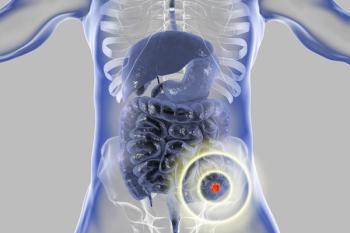
Oncology NEWS International
- Oncology NEWS International Vol 19 No 6
- Volume 19
- Issue 6
PET unable to reliably identify post-Rx colon mets
Metabolic inhibition by chemotherapeutic drugs most likely hampers imaging results.
ABSTRACT: Metabolic inhibition by chemotherapeutic drugs most likely hampers imaging results.
For post-treatment assessment of colorectal hepatic metastases, stick with MRI or CT imaging for an accurate depiction of how the tumor is faring because PET scans come with a high false-positive rate. That's the conclusion of a study conducted by surgical oncologists at Houston's M.D. Anderson Cancer Center.
Currently, chemotherapeutic agents can render unresectable lesions more amenable to surgery and the standard approach to surgical planning is with contrast-enhanced CT or MRI. While FDG-PET certainly has a place in oncology imaging, "exactly what PET adds to surgical decision-making remains unclear," wrote Evan S. Glazer, MD, Steven A. Curley, MD, and colleagues in the Archives of Surgery. "There appears to be a correlation between decreasing PET uptake and reduction in tumor burden; however, hypometabolic lesions may still harbor viable malignant cells. The impetus for this research was finding viable cancer in patients with clearly negative PET findings."
VANTAGE POINT
JAMES C. HEBERT, MD
Drawing attention to the limitations of PET imaging
Dr. Curley and colleagues have highlighted the limitations of PET in predicting response to chemotherapy, wrote Dr. Hebert in an accompanying commentary. "As the authors postulate, chemotherapy interrupts the metabolism of tumors cells to induce apoptosis and cell death. Some cells may survive with metabolic activity similar to that of surrounding tissue and thus cannot be detected on PET four weeks after chemotherapy," he said (Arch Surg 145:345, 2010).
In addition, positive PET results did not change the surgical plans, said Dr. Hebert, who is from the department of surgery at the University of Vermont College of Medicine and Fletcher Allen Healthcare in Burlington.
The optimal timing for PET after chemotherapy is currently not known, but it's likely that false-negative scans may be less of an issue with a longer interval after therapy. Nonetheless, PET "is expensive and should be used only if the results will alter management. Why should we trust a negative PET finding six weeks after chemotherapy? I hope that the authors and others will continue to evaluate this in well-managed trials," he said.
For this review, the authors tapped into their institution's database and found 138 patients who had undergone at least one PET scan after chemotherapy and before liver intervention. All PET studies were performed in the latter half of the chemotherapy regimen or within four weeks of chemotherapy coming to an end.
STEVEN A. CURLEY, MD
The primary diagnosis was adenocarcinoma in 136 patients and mucinous colonic carcinoma in two patients. The initial diagnosis of hepatic metastases was made using PET in 28.3% of the 128 patients, and 49% of these patients underwent resection without additional imaging. One patient had negative CT results but a positive PET scan. Among patients with biopsy-proven disease, 87% underwent hepatic resection. Chemotherapy, including FOLFOX with bevacizumab (Avastin) or cetuximab (Erbitux), was deliveed for four weeks or less prior to liver resection.
The false-negative rate for hepatic metastasis on PET was 86.7% with a negative predictive value (NPV) of 13.3%. PET yielded 116 true positives, 13 false negatives, seven false positives, and two true-negative findings (Arch Surg 145:340-345, 2010).
After chemotherapy, more than 85% of the patients had a reduction in hepatic tumor burden that was greater than 25%. At a median follow-up of 15 months, the survival rate was 93.5%.
TABLE PET statistical measures
While the sensitivity of PET was high at 89.9% (see Table), the authors pointed to the NPV of 13.3% as a more telling statistic. "Comparing false-negative with true-negative findings yields a slightly different picture: an 86.7% false-negative rate (equivalent to a 13.3% NPV). That is, when the PET finding is negative, it cannot be trusted."
The NPV is dependent on the population being studied: The prevalence of early hepatic metastatic disease is high whereas PET findings will be positive only for metabolic activity above baseline, they said. Effective chemotherapy will bring about cell death or at least decrease malignant cell metabolic activity. But PET most likely would not yield useful information until malignant cells have recovered enough metabolic activity to distinguish them from surrounding tissue, the authors stated.
Finally, no survival benefit was seen for the group that underwent PET imaging. The authors suggested that if the time between the last round of chemotherapy and imaging is six weeks or greater, then PET/CT with reconstruction is an option. But if chemotherapy is ongoing or has been administered within six weeks, then the same imaging modality (preferably CT or MRI) should be used before and after treatment.
"Although imaging techniques are very valuable, functional studies are not sufficiently accurate for surgical planning. . .prior comparisons are one of the most important tools in determining the likelihood of a malignant lesion and response to therapy," they said.
VANTAGE POINT Results do not denote lack of efficacy for FDG-PET/CT in colon cancer metastases
DAVID MANKOFF, MD, PhD
CHAITANYA R. DIVGI, MD
ROBERT W. ATCHER, PhD, MBA
This well done study from a recognized group highlights an important point for molecular imaging with FDG-PET/CT: An absence of uptake post-therapy does not necessarily indicate absence of viable tumors, said Dr. Mankoff, Dr. Divgi, and Dr. Atcher.
Dr. Mankoff is a professor of radiology, medicine, and bioengineering in the department of nuclear medicine at the University of Washington in Seattle. He is also a member of the Seattle Cancer Care Alliance. Dr. Divgi is a professor of radiology and division chief, nuclear medicine and clinical molecular imaging, at the Hospital of the University of Pennsylvania in Philadelphia. Dr. Atcher is professor of pharmacy at the University of New Mexico/Los Alamos National Laboratory in Albuquerque.
Previous studies in a variety of tumors have consistently shown that patients who achieve an absence of tumor FDG uptake post-therapy ("complete metabolic response") have better outcomes than those whose tumors are still detectable by FDG-PET post-therapy (J Nucl Med 50:1S-10S, supplement 1, 2009).
However, despite the positive prognostic indication carried by the absence of FDG uptake after successful therapy, a complete metabolic response is not always equivalent to a complete histologic response. Studies in other cancers have shown that the sensitivity of FDG-PET/CT for small-volume residual treated cancer is low, and that FDG-PET may miss small-volume or microscopic residual disease after systemic therapy (Br J Cancer 102:35-41, 2010).
This is not surprising. FDG uptake is highly sensitive to chemotherapy and provides an early indicator of response. It would be difficult for a response evaluation method to be highly sensitive to the early effects of therapy as well as a sensitive marker of residual disease post-therapy. Timing with respect to therapy is a key to interpreting results of FDG-PET/CT. Pretherapy FDG-PET/CT provides a sensitive and accurate tool for determining the extent of metastatic colorectal cancer, and prospective randomized trials have supported its utility in directing surgery (J Nucl Med 50:1036-1041, 2009).
However, an absence of FDG uptake at the completion of systemic therapy does not mean that the disease has been eradicated. Dr. Glazer and colleagues are correct in concluding that caution is needed in using post-therapy FDG-PET/CT to direct resection. The high postive predictive value post-therapy found by the authors supports the role of FDG-PET/CT as an indicator of response and, importantly, of therapeutic failure.
While this study clearly indicated caution in using post-therapy FDG-PET/CT to direct surgery, the results should not be taken as a lack of efficacy for FDG-PET/CT in managing metastatic colorectal cancer, for which PET has, and should continue to play, an important role in directing management.
Articles in this issue
over 15 years ago
Nobel laureate heads up NCIover 15 years ago
Cleveland Clinic nets federal funds for research facility revampover 15 years ago
Diabetes drug acts as chemopreventive in smokersover 15 years ago
FTC extends deadline for Red Flags Rule on patient privacyover 15 years ago
Breakthrough cancer-related pain: The truth hurtsover 15 years ago
African-American genetic mutations pose Rx challengeNewsletter
Stay up to date on recent advances in the multidisciplinary approach to cancer.

















































































